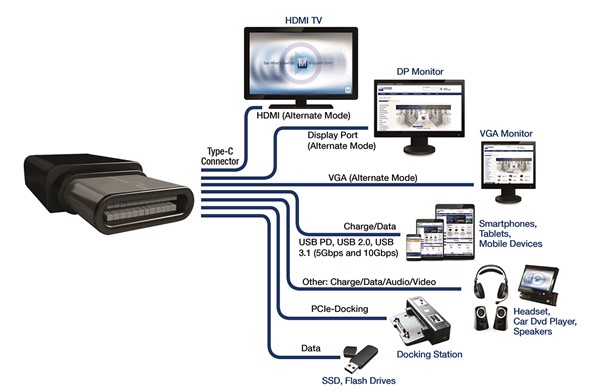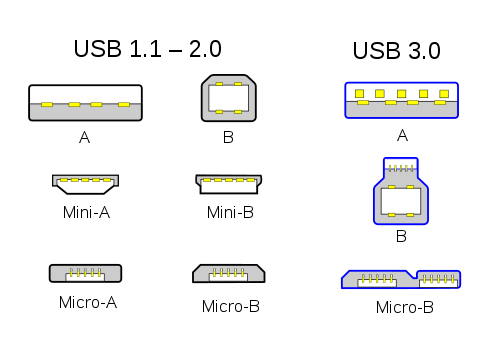The origins of the USB specification as we know it can be traced back to the Implementers Forum (USB-IF), a non-profit organisation which was founded in 1995. USB-IF was founded by a group of companies with a vested interest in USB, most notable of which are Microsoft, Intel, Apple, HP, IBM and Compaq.
Consequently, USB-IF was tasked with developing, promoting and maintaining USB standards. Currently, the organisation is actively promoting the adoption of Wireless USB, USB On-The-Go, USB C to USB 4.
Applications of the USB standard
The fundamental purpose of the USB standard encompasses the broader functions of device connection (and communication) as we shall talk about in a little while. Furthermore, USB increasingly functions as a battery charger for supported devices utilising the increased power capacity of USB C to USB4. USB cables and their corresponding ports are used in innumerable devices in the home/school/work/gaming environment. A few examples of these include computers, computer keyboards, mice, flash drives, printers, scanners, video game consoles, digital cameras, portable drives, MiFis, dongles, smartphones, tablets, IoT devices, e.t.c. In addition to this, these connectors also make an appearance in motor-vehicle and home charging docks negating the need for adapters (charger heads). Read more
A Wingle is a USB dongle with a hotspot featureChoosing the best Computer Mouse: Wireless (RF vs Bluetooth) vs Wired USB MouseHow to do Android USB tethering to share fast internet with your computerChoosing the best Computer Keyboard: Wireless (RF vs Bluetooth) vs Wired USB Keyboard
USB versions
Ever since its release in 1996, there have been four generations of USB specifications: USB 1.x, USB 2.0, USB 3.x and the newly announced USB 4. Here’s a breakdown of the incremental improvements over the years: As you can see above, there’s a naming rigmarole concerning USB 3.x. Once upon a time, USB 3.0 meant USB 3.0, end of story. However going forward, USB-IF recommends classifying USB 3.0 packing 5Gbps as USB 3.2 Gen 1, for some convoluted reason. Subsequently, what we call USB 3,1 offering 10Gbps will be classified as USB 3.2 Gen 2. Meanwhile, the actual USB 3.2 will be classified as USB 3.2 Gen 2×2. Good luck making head or tail of that. Luckily, consumer side, all you need to remember is the advertised consumer name. USBs with speeds of 480Mbps are labelled as High Speed (like your Micro-USB cable). Anything exceeding 5Gbps is SuperSpeed (abbreviated as SS on your device). Even greater data transfer speeds than this (10GBps~ 40Gbps) which we will see in USB C to USB 4 are marketed as SuperSpeed+ Related
How to tell the version of USB ports on your computer.USB 3.2 standards explainedUSB 4 release date and what to expectWhat is the difference between a flash drive 2.0 and 3.0?
USB Connectors
The USB standard uses an alphabetical naming scheme for its connectors. Like humans, these connectors can be male (the plugs) and female (the ports/receptacles). They can also be male to male, or female to female depending on their function. Type-A and Type B connectors are supported by all USB versions starting with 1.0 and backwards compatible. While not always the case, these connectors are colour coded in order to differentiate them. USB 3.0 connectors are usually blue while USB 2.0 and USB 1.1 connectors are often black.
Standard A (USB Type-A)
Officially called Standard A, Type-A is the original and perhaps the most recognizable connector in use today. It’s that flat, rectangular USB port (or a receptacle) on your laptop and that Type-A plug connecting your peripherals to a computer, TV, video player, e.g. printer, scanner, smartphone, keyboard, mouse, flash drive e.t.c. Most flash drives are Type-A male connectors (plugs).
Standard B (USB Type B)
USB Type B connectors differ from USB Type-A connectors in that they are square in shape. Additionally, they can either have another square protrusion or a three-sided protrusion on top depending on the USB version. They are commonly used in printers and scanners. Unfortunately, due to design changes in USB Type B plugs and their ports, they are not backwards compatible with USB 1.1 Type B and USB 2.0 Type B. Nevertheless, USB 1.1 Type B and USB 2.0 Type B are both physically compatible with USB 3.0 Type B.
Mini and Micro USB
Mini A and Mini-B connectors were the first small-sized connectors developed for use in portable devices such as earlier digital cameras and smartphones. However, Mini-A plug and the Mini AB port have since been deprecated and replaced with Micro-B connectors. The currently ubiquitous Micro-B USB connector was announced on the cusp of the rise of Android. This inadvertently led to its global dominance and the subsequent demise of USB Mini connectors. Micro-B USB was thinner, smaller, and more durable than their Mini USB counterparts and soon became the standard connector for smartphones.
USB-C/USB Type C
The USB standard underwent a significant design change with the introduction of USB-C. Formerly known as USB Type C, USB C connectors feature a unique symmetrical oblong shape. Unlike previous standards, the USB-C design is totally reversible, meaning that whichever way you plug it in is the right way. More to that, unless paired with adapters, USB-C is not physically backwards compatible with previous connectors although it supports previous USB versions. In USB-C’s quill of arrows is its ability to transfer data super fast. Secondly, it can receive and provide enough juice to power entire devices. Last, but not least, USB-C can support connections to Thunderbolt 3 enabled devices. That’s because USB-C is a physical connector/interface while Thunderbolt 3 is a data transfer specification. Read more
The difference between Micro USB and USB-C USB 3.0, 3.1, 3.2, 4.0 and Thunderbolt specs and feature comparison USB-C is not perfect. Top 5 issues facing USB-C connector
USB On-The-Go
USB On-The-Go (OTG) is a connection standard that allows a smartphone to read data directly from a USB device. In effect, the smartphone serves the role of a laptop and becomes the USB host.
You can transfer media to and from your smartphone using special adapters or double-ended flash drives (those that have both Type-A and Micro-B plugs). Other ways to use USB On-The-Go include using peripherals like a keyboard or a mouse on your smartphone. You could also play games with actual video game controllers.
That said, not every device supports USB On-The-Go although a number of Android devices do. The standard requires the port to be a Micro-AB receptacle. A Micro-AB receptacle or port is indistinguishable from a Micro-B port in smartphones.
Read more:
Connect Flash disk to your phone with USB On-The-Go (OTG) and move with your media files Run Windows 10 directly from a USB FlashHow to connect two Windows PCs with a USB-to-USB cable
Universal Serial Bus or USB has undergone a series of upgrades since its initial release in 1996. Each standard and version and connector from USB 1 to USB C to USB 4 has been one step closer to a truly universal multi-purpose connector.





